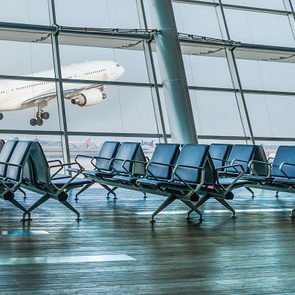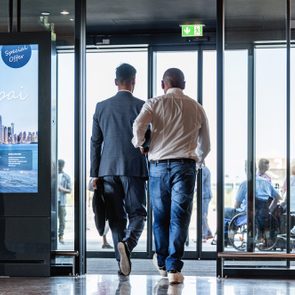Hate waiting around baggage claim after a long flight? Try our expert advice on how to be first out of the airport doors.

This Simple Trick Could Help Your Suitcase Arrive Early at Baggage Claim

As any flier knows, airports are waiting games. But while snaking check-in and security lines are grudgingly accepted as the cost of doing business, we want things to go quickly once we land. Which is why I get downright grumpy when my luggage is slow to appear at baggage claim. There’s nothing worse than watching others excitedly pull their bags off the conveyor belt as I’m left to hover and hope that my bag isn’t lost. I know I’m not the only one who feels this way.
While there’s no guaranteed way to get your suitcase out first from the belly of the beast, experts say there are tricks you can try that will up your chances of a speedy recovery. Read on to learn what they are.
Get Reader’s Digest’s Read Up newsletter for more travel news, tech, cleaning, humor and fun facts all week long.
What’s the trick that could help your suitcase arrive first in baggage claim?

Your best bet at getting your suitcase to slide first down the chute, say experts, is to have a priority tag on your luggage. Brightly colored, these are put on at check-in and usually loop onto your luggage beside the barcoded bag tag that all passengers receive. Importantly, they’re a signal to baggage handlers that the luggage belongs in a separate cart and/or bin and should be put on conveyor belts first.
How do you get these tags?
These tags are generally available for two types of fliers, says Nick Ewen, senior editorial director at The Points Guy. The first are those who book a higher class of service. “This is generally business or first class, though it depends on the airline,” Ewen says. In these cases, the priority tag is a given and should be included among the more costly ticket’s perks.
The other category is fliers with a particular tier of elite status through an airline’s frequent flier program, such as Delta Sky Priority’s Medallion class. “And in that case,” explains Ewen, “it doesn’t matter which class you fly in. You can be on a basic economy ticket and still be eligible for priority handling.” While credit cards associated with individual airlines don’t directly get you that priority tag, he adds, they do count your spending toward qualifying status for the tag and other perks.
There is, of course, a folksier way to snag one: Chat up your check-in agent and ask nicely to have one put on your bag. “I’m a big believer of ‘it never hurts to ask,'” says Ewen. You might just get one, especially if your flight has been delayed and there’s a chance you’ll miss your connection.
What else might help your bag get to the front of the line?
A priority tag isn’t the only way to help encourage your bag to arrive earlier. Here are a few other strategies you can try:
Gate-check your bag
With passengers increasingly pressured to check in carry-on bags at the gate, it makes sense to wonder if there’s any upside to doing so. Well, there might be! Not only can you save your back (or prevent hitting a seatmate with a flying object) when wrangling your suitcase into the bin, but regional carriers might also have your carry-on luggage waiting for you right by the plane, saving you a trip to baggage claim.
In general, however, these bags are loaded into the aircraft bin with the others and go through the same process as any other checked bag.
Check in last
While a later check-in carries the risk of missing a flight—in other words, be careful with this one—there’s plenty of anecdotal evidence that it sometimes brings good news at the other end: Your bag, which was loaded late, might be among the first out of the cargo hold and on its way to the conveyer belt.
Have a guarantee
Another way to ease your pain at the carousel: When possible, consider flying one of the two airlines with a baggage guarantee. (Not to be confused with compensation for lost or delayed luggage.) Both Delta and Alaska Airlines promise compensation if checked bags are not delivered within 20 minutes of the plane parking at the gate, says Ewen.
At Delta, baggage that lags makes you eligible to receive 2,500 bonus miles after completing an online form no later than three days after your flight’s arrival. You must be enrolled in SkyMiles (easy to do) and have flown on a domestic flight.
Alaska Airlines’s 20-minute bag guarantee results in a $25 discount code for use on a future Alaska Airlines flight, or 2,500 Alaska Airlines Mileage Plan bonus miles. There’s no online form. Instead, you need to speak with someone at the airport baggage office within two hours of your flight’s arrival.
(Be sure to check the fine print on these programs, on both airlines’ websites.)
Be proactive
The simplest way to ensure you’re not standing around is to double-check the baggage tag when it’s printed out at check-in. Baggage tags contain your name, flight number, origin city and destination. Now is the time to catch any mistakes.
You should also remove all old luggage tags, as leaving them on could confuse baggage handlers, who may accidentally load your luggage on a flight headed to your former destination. The same goes for those barcode airline stickers. They also need to come off before you reach the airport.
Additionally, throwing an Apple AirTag into your bag helps you track its progress and serves as an early alert if something goes awry.
You should also make sure you’re given that priority tag if eligible. For those who use a self-service kiosk to check in, ask for the tag at the preferred drop-off area.
What else should you keep in mind?
Manage your expectations. With air travel predicted to reach record highs this summer, airports and airlines don’t always have enough baggage handlers to handle the volume efficiently. So far this year, some 42 million bags have been tagged and packed into airplane cargo holds. Experts caution that no matter the method you tried to get your luggage to come down that chute quickly, you should take a deep breath once you get to baggage claim and know that you’re almost done with the airport portion of your trip, regardless of the placement of your bag on the belt.
RELATED:
- New Study: If You Fly Out of This Airport, Be Prepared to Wait Around 50 Extra Minutes Before Takeoff
- You Can Now Keep Your Shoes On When Going Through Airport Security—Find Out Which Other Rules Might Be Dropped Next
- The New Gen Z Travel Trend You Won’t Want to See at the Airport
About the expert
|
Why trust us
Reader’s Digest has published hundreds of travel stories that help readers explore the world safely, easily and affordably. We regularly cover topics such as the best places to visit (and the best times to visit them), tips and tricks to zoom through airport security, flight-attendant secrets, hotel-room hacks and more. We’re committed to producing high-quality content by writers with expertise and experience in their field in consultation with relevant, qualified experts. We rely on reputable primary sources, including government and professional organizations and academic institutions as well as our writers’ personal experiences where appropriate. We verify all facts and data, back them with credible sourcing and revisit them over time to ensure they remain accurate and up to date. Read more about our team, our contributors and our editorial policies.
Sources:
- Nick Ewen, senior editorial director at The Points Guy; phone interview, July 6, 2025
- Delta: “Sky Priority”
- View from the Wing: “Passengers Are Being Forced to Gate Check Bags”
- AAA’s The Extra Mile: “3 Ways to Have Your Luggage Arrive First at Baggage Claim”
- Reddit: “Secret to your bags being unloaded first”
- Delta: “20-Minute Bag Guarantee”
- Alaska Airlines: “Our 20 minute baggage guarantee”
- DW: “Air travel: Revenues, flyers to hit post-COVID record highs”
- U.S. Department of Transportation: “May 2025 Air Travel Consumer Report”
- Flyer Talk: “Priority Baggage”
- Research and Markets: “Airport Baggage Handling Systems Global Analysis Report 2024–2030”























